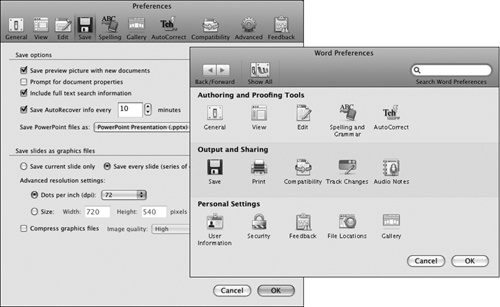You can change the appearance and behavior of an Office program in many ways. You can manage the program options in Word, Excel, PowerPoint, or Entourage by clicking Preferences on the program menu (for example, the Word menu) that is on the menu bar to the right of the Apple menu.
Each Preferences dialog box displays buttons representing groups of program settings. Clicking a button displays the program settings specific to that group. In Word and Excel, you can enter terms related to the program settings that you want to change into the Search box located in the upper-right corner of the Preferences dialog box. A list of topics containing the search term appears instantly, and as you continue to type, Spotlight filters the list and spotlights the icons representing the dialog boxes from which you can set the options shown in the list.
The Preferences dialog boxes for Word, Excel, and PowerPoint all include these eight setting groups:
General. The commands on this page control basic settings specific to the program.
View. These commands control the display of content and program elements (such as scroll bars).
Edit. These commands control the way the program behaves when you’re typing, pasting, or moving content within an Office file.
Save. These commands control the information saved with each Office file and the frequency with which the program saves temporary AutoRecover versions of your documents. If the program crashes and you haven’t recently saved open Office files, AutoRecover is your very good friend!
Gallery. With these commands, you can customize the appearance and activity of the Elements Gallery.
AutoCorrect. These commands let you control the AutoCorrect feature that corrects common misspellings and typing errors, applies basic capitalization rules, and changes certain character combinations to symbols. (For example, AutoCorrect will change (c) to ©, a copyright symbol.)
See Also
For information about other features accessed through the AutoCorrect group, see "Word Tools and Preferences" earlier in this chapter.
Compatibility. These commands control settings related to the Compatibility Report feature.
Feedback. With these commands, you can opt into or out of the Microsoft Customer Experience Improvement Program. If you do participate, a background utility collects anonymous data about your computer and your usage of Microsoft software and services, and transmits that data, from time to time, to Microsoft. This doesn’t affect the speed of your computer.
In this topic, we discuss some of the ways you can personalize Office that are common to all the programs.
During the installation process, the Office 2008 programs import the user information you provided during the computer setup process. This might include your name, initials, company, address, telephone number, and e-mail address. Office programs display and use this information. For example, your user name appears on the program splash screens, in comments you insert into Office files, when setting up an e-mail account, and in the properties saved with files you create.
If the current user information isn’t yours, contains an error, or just doesn’t say what you want it to, you can easily change it. Changes you make to your user information from Word, Excel, PowerPoint, or Entourage are immediately reflected in the other programs. All the Office programs have access to the user information you supply in any one program. The programs will automatically refer to the up-to-date information when you create documents.
Each of the Office programs stores only the information that will be used in that program:
PowerPoint stores only your name and initials. You can edit these by clicking the Advanced button in the PowerPoint Preferences dialog box.
Excel stores only your name. You can edit this by clicking the General button in the Excel Preferences dialog box.
Word stores quite a bit of information, if you provide it. You can use the stored information in your documents; for example, in letters and on envelopes. Documents you create from the Project Gallery might include pertinent information from your user profile. For example, a fax cover page created from the Project Gallery automatically displays your company name.
Entourage creates a contact record in the Address Book by using the available personal information.
To change your Office user information or save more information as part of your personal contact record, from Word, follow these steps:
In the Word Preferences dialog box, under Personal Settings, click the User Information button.
In the User Information dialog box, change any of the basic data shown; or click More to open a multipage dialog box in which you can record and manage your home, work, and personal information.
The content in this dialog box is the same as that shown in your Entourage contact record.
Each of the Office programs has an associated color—blue for Word, green for Excel, orange for PowerPoint, and purple for Entourage. These colors are visible on the program icons in the Dock, on the file icons in the Finder, on the program splash screens, and in the Elements Gallery and Toolbox in Word, Excel, and PowerPoint.
You can change the color scheme of the Elements Gallery and Toolbox, or customize the appearance and performance of the Elements Gallery, from the Gallery page of the Preferences dialog box.
In the General area, you can control whether the Elements Gallery opens automatically when you start a program, and whether the element thumbnails increase in size when you point to them in the Elements Gallery.
In the Appearance area, you can change the color displayed in the Elements Gallery and Toolbox from the program-specific color to graphite, and control the transparency (on a scale from 0 to 10 percent) of the Elements Gallery.




